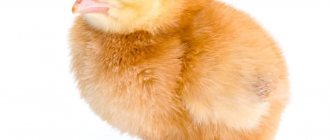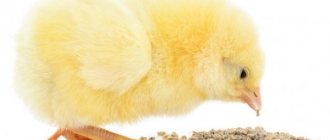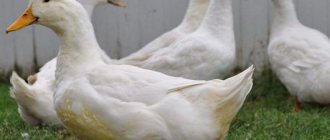Proper raising of chickens at home will allow you to renew your flock with minimal material costs. The process is not complicated. Even novice farmers can handle it. The main thing is to create comfortable conditions for the chicks, providing them with nutritious and balanced food and care. And maintaining the required temperature, humidity level and daylight hours for them. Walking and preventive measures are also important.
We hatch chicks
From under the hen
To ensure that the hen sits on the eggs properly, set up the nest in a dark and quiet place. Away from other birds.
Sometimes hens get so carried away with “motherhood” that they stop leaving the nest. Be sure to supervise the bird. If necessary, remove her from the eggs twice a day and take her to the feeder and bowl of water.
The natural way of raising chicks is the easiest. You don't have to think about how to raise chickens. And control how they hatch.
Read more about this breeding in the article “Organization of hatching of chickens by a hen.”
Using an incubator
Incubators are a more productive option. In one go, you can load 50 or more hatching eggs into the “electronic hen”. The hatching of chicks, as well as under the hen, occurs almost simultaneously.
These devices are easy to use. And can be used all year round. Modern automatic incubators regulate heat and humidity themselves. And they even turn eggs. You can buy such a miracle of technology in Moscow and any city in Russia.
More useful information in the article “How chickens hatch in an incubator at home.”
Whether in an incubator or under a hen, the chicken hatches after the same time, 20 or 21 days after laying the egg.
Let's say right away - you shouldn't put hatched chicks in a chicken coop. Since in a large room it is more difficult to maintain the desired temperature and humidity.
What do chickens look like?
A chick in the first month of life is yellow, with a red beak and beady eyes. With age, feathers grow, height and weight increase.
Diagram of a chicken egg opened at the beginning of incubation
The shell protects the embryo from external damage. Although it seems quite fragile, it will not be possible to break it at once. For its formation, chicken requires calcium salts. Upon careful examination of the shell, you can find pores in it through which the embryo breathes. The embryo begins to develop when the egg from the egg enters the hen's oviduct. As soon as the laying hen lays it, the future chicken stops developing. For the embryo to continue to develop, a temperature of 40°C is needed. In the incubator it is maintained effortlessly all the time; the hen also does not experience any difficulties during incubation, but at home it is difficult to maintain such a regime.
As soon as the chick hatches, it can already stand firmly on its feet. The chicken is covered with yellow down.
Embryo at a later stage of incubation (14 mm)
Raising day old chicks
To pick up or not
If the chicks were hatched by a hen, then they should be left with her. This will greatly simplify the process of raising chickens at home for beginning farmers.
Newly hatched chicks are taken from a hen only if she has left offspring. Or if you want the hen to continue producing eggs.
In this case, the laying chicks are removed from the nest gradually. But so that the chicken doesn’t notice it. Otherwise, she will stop hatching the remaining eggs.
First hours of life
If you used an incubator, do not remove the chicks from there as soon as they have time to hatch. You need to wait an hour and a half for the babies to dry completely.
Please note that day old chicks are very susceptible to temperature changes. Therefore, they need to be moved to a special box.
Handle the chicken delicately, placing it in the palm of your hand. It is unacceptable to hold the chick by the head, paws or wings. Chicks hatch very fragile. And you can easily injure them.
To learn how to raise healthy and strong chickens, read on carefully.
We place the chicks in the “nursery”
Now let's figure out how to keep chickens after the incubator, when they have all hatched and dried out.
Chicks require special care in the first weeks of life. The ideal option is a brooder. This is a specially equipped box with controlled temperature, humidity and lighting.
Here you can easily create a microclimate in which day-old chicks will feel great.
You can make such equipment yourself. For step-by-step instructions, read the article “Building a Do-It-Yourself Brooder for Chickens.”
If you do not have such a box, a regular box with fairly high walls will do, where you can mount heating and lighting systems.
Although it will be a little more difficult to raise chickens at home. You will have to manually adjust the temperature. And figure out how to humidify the air.
Preparing housing
It doesn’t matter what kind of “nursery” you use: factory-made or self-made. In any case, before moving in the chicks, the housing must be thoroughly disinfected.
Maintaining hygiene is important when raising both small broilers and laying hens at home.
It is necessary to treat not only the pallet, but the entire box: floor, ceiling and walls. This must be done to ensure that the day-old chicks housed there do not catch the infection and get sick.
You can easily find special medications at any veterinary pharmacy. Virotsid, Alaminol or their analogues are suitable for these purposes. You can also use ordinary solutions: saline or manganese.
Population density
Please note that as the chicks grow, they will need more space.
One-day old babies can be housed at 12-15 heads per 1 sq. m.
In two weeks, no more than 10 birds will be accommodated in this area.
And at 3-4 weeks - no more than 7 individuals.
Breeding chickens in violation of these standards can cause their poor health and death.
Next, we will tell you how to care for chickens in the first 4 weeks of their life.
Vaccinations for chickens at home
Vaccinations help develop immunity in birds to certain diseases. It is better to vaccinate at a veterinary clinic, but if you follow a number of rules, it can be done at home.
How to care for chrysanthemum
Before starting vaccination, you need to know the epidemiological situation in the region. You should also pay attention to where the chickens are bred.
Important! There are a lot of chicken diseases that spread extremely quickly and can become epidemic. Some of the diseases can be dangerous even to humans.
To carry out vaccination you will need:
- a drug;
- cotton wool and liquid for sterilization;
- syringe (for subcutaneous and muscular injections) or pipette (for ocular administration);
- sprayer for one-time vaccination of livestock;
- ice and distilled water.
Vaccinations can only be given to healthy chicks, as chickens with weakened immune systems may not survive vaccination and die.
The simplest method of vaccination is eye or nose drops. The drugs are sold already with a solution for dilution. However, you need to make sure that the medicine remains cold. It is better to carry out this vaccination together.
Intramuscular injections also require two people. The needle should be inserted at an angle of 45° into the breast, 2.5-4 cm from the keel bone.
Chicken bone structure
If there are a lot of chickens, spraying is the ideal vaccination option.
During the week after vaccination, you need to carefully monitor the condition of the chicks; some may experience complications.
Chicken vaccination scheme
We equip the chicken house with everything necessary
Choosing litter
In the first three days, it is advisable to cover the floor of the box with a soft cloth. It must be changed when it gets dirty.
Please note that day-old chicks can climb under the fabric, become entangled in it and die. Therefore, in the first days they need to be carefully monitored.
Then you can pour peat, shavings, and straw onto the bottom of the box.
Sawdust is the least suitable material here, as chickens may start pecking at it.
Therefore, it is advisable to use sawdust when the birds reach two weeks of age. And another important point - only conifers are suitable. The sawdust is too sharp. Babies can get hurt.
Containers for feed and water
Proper care of day-old chicks involves equipping their housing with the correct containers for feeding and watering.
A feeder for chicks should be stable, comfortable, and safe. And made of material that is easy to wash. No sharp edges are allowed.
It is important that all chicks can eat at the same time. Otherwise, stronger individuals will repel weaker ones from eating. Such a chicken may die over time.
In the first two to three days, you can use a regular plastic lid for jars as a drinking bowl. Then it is advisable to replace it with a nipple or vacuum device for supplying water.
You should not continue to use an open type drinker. Leftover food, debris and fluff will end up there. As a result, the liquid will quickly become contaminated and deteriorate.
Heating and lighting
An infrared lamp is ideal for maintaining the desired temperature in the box. It is both a source of light and heat.
The main advantage: it heats the entire house evenly. Therefore, there are no “cold” or “overheated” areas.
A description of other heating and lighting devices is given in the article “Lamps and other devices for heating chickens.”
We will equip the corral
If you are keeping older chicks in a pen, it is important to make the right fencing. The ideal option is a mesh stretched over bars. A solid “fence”, for example made from a sheet of plywood, will deprive children of sunlight.
The main thing is to choose the right grid. It should be fine-mesh. Otherwise, the chickens may crawl out through the voids in the net, get stuck in it, and be injured. And even die. The ideal cell size is 1.5x1.5 cm.
When attaching the mesh to the frame, make sure that there are no sharp nails or wires protruding from the structure, which could injure the chicks.
Keeping it clean
Here we will talk about the basic rules for hygienic care of chickens at home.
It is necessary to carry out regular cleaning in the chick house. Change the litter when it gets dirty. Wash the drinking bowl and feeder twice a day. And be sure to remove food that the chicks haven’t eaten. Including the one they scattered on the floor.
Keep in mind that the temperature in the “nursery” is high. And within an hour the food can go bad.
Lighting and temperature
In the first days of their life, chicks often freeze or, conversely, suffer from very high temperatures in their home. This is due to the fact that the young body does not yet know how to adapt to the ambient temperature and regulate body temperature.
This is why it is necessary to very carefully control the temperature in brooders and chicken coops when raising chickens. It is worth paying attention to such things:
- In the first days after the chicks hatch, it is necessary to place them in conditions that will be as similar as possible to the conditions of incubators. To do this, the air temperature is heated to approximately thirty-five degrees.
- The second day of life of chickens must begin with cooling the room in which they live. However, this must be done gradually. The first week of life of chicks can take place at a temperature of about thirty degrees.
- Heating should be carried out not only during the day, but also at night. Particular attention should be paid to the temperature in bad weather and frosts.
- From the second week of the chicks’ life, you can lower the brooder temperature to twenty-eight degrees. Week-old chickens will feel comfortable at temperatures from twenty-one degrees.
- Temperature is measured using a thermometer. It is best to attach the device slightly higher from the floor, at the height of the chickens. This will help you find out the exact temperature in the bird’s habitat area.
By the behavior of the chickens, you can determine whether they live comfortably in the chicken coop. Let us highlight the factors that indicate a violation of the content:
- If birds gather near a lamp and press themselves against each other, then most likely they are cold.
- When the temperature rises excessively, Brahma chickens ruffle their feathers and wings, begin to move less and lie down on the floor.
In addition to controlling the temperature, it is worth monitoring the lighting in the chicken coop. For the first few days, the lamps are left on continuously. This is necessary so that the chicks begin active feeding and grow faster.
Further, the chicks gradually begin to adapt to the dark. First the lights are turned off for fifteen minutes, then for thirty minutes. Every day this figure increases until it reaches the desired state.
Microclimate
Temperature and humidity
The temperature at which the chicks are kept is very important. Overheating and hypothermia are equally dangerous for them.
In the first hours of life, chicks are sensitive to any climatic changes. Therefore, after moving them into the box, the thermometer should show at least 35 degrees. This temperature must be maintained for 24 hours.
Then, over the course of a week, it is gradually lowered to 30-32 degrees. When the babies turn 14 days old, it is again gradually reduced every day. So that by 30 days it does not exceed 21 degrees.
The heating requirements for a chicken “kindergarten” are described in detail in the article “Temperature conditions for chickens in the first days of life.”
The humidity in the box is maintained at about 75% for a week. From 7 to 14 day – 70%. And then they gradually reduce it to 65% for up to a month.
Day and night mode
Keeping chickens after an incubator implies the presence of a certain light regime. In the first days of life, chicks need lighting for 20-24 hours.
After 4-5 days, daylight hours begin to gradually decrease. So that by two months it does not exceed 12-14 hours.
Fresh air
Automatic or natural ventilation will help to avoid high humidity, musty air and unpleasant odors in the chick house.
In the first week, you can simply ventilate the box by lifting the top lid several times a day. Then it is advisable to equip a ventilation system.
Day-old chicks at home, as well as older ones, must be protected from drafts. They are very dangerous - babies can easily get sick.
What signs are used to determine age?
In the vast majority of cases, the age of chickens is determined by their plumage:
- at 8-12 days, feathers appear on the shoulders;
- at 12-16 days the chest and crop fledge;
- three-week-old chicks are in a state of molting (the fluff on the tail is completely absent);
- at the end of the fifth week, the chicks grow flight feathers and feather their backsides;
- in six-week-old chicks, the head and lower body feather;
- Three-month-old chicks are fully feathered.
Be sure to read:
How often do chickens lay: how many eggs do they lay per day, week, month and year, what determines the number
Feeding
Menu
Let's consider one of the options for feeding chicks depending on age.
From zero to 3 days: from the first day of life, the portion of food per individual should be 15 g. Diet: 2 g of crushed yolk. 2 g finely chopped green onions. 5 g millet. 1 g cottage cheese. And 5 g of yogurt.
From 4 to 14 days: food portion - 25 g. Menu: 9.5 g of cottage cheese. 2 g boiled egg. 3 g green onions or nettles. 0.5 g chalk. 10 g millet.
From 15 to 21 days: food portion - 44 g. Diet: 19 g of millet. 5 g of boiled potatoes or carrots, peeled and chopped. 1 g meat and bone or fish meal. 7 g each of yogurt and greens. 4.5 g cottage cheese. 0.5 g cake.
From 22 to 31 days: serving - about 66 g. Menu: 22 g of millet. 10 g of boiled potatoes and herbs. 20 g yogurt. 0.6 g cake. 1.4 g fish or meat and bone meal. 1 g each of chalk and pebbles.
Complementary feeding rules
If day-old chicks do not eat food, simply tap it with your finger, imitating the movement of the beak. And the kids will understand what to do next.
For the first 3-5 days, baby food should be moist but crumbly. So that they do not clog the chicks' airways.
The topic is discussed in more detail in the article “What to feed chickens at home from the first days of life.”
Drink
Proper care and feeding will not yield results if you do not water the chicks correctly.
When the baby has just hatched, he should not be given cold water. Chicks should drink boiled liquid heated to 20 degrees.
To raise healthy chickens, they are given vitamins along with their water. The most commonly used is Chiktonik. In a proportion of 1 ml per liter of water.
The drug must be diluted strictly according to the instructions. First, the bird is given a “supplement.” And after 1.5-2 hours they begin feeding.
From 4 days you can add a little potassium permanganate to the drinking water for chickens. To prevent stomach diseases.
Content
As mentioned above, keeping chickens comes down to creating a suitable temperature regime, humidity level, and suitable daylight hours for them. The room should be equipped with good ventilation, the house should be warm and dry, and the number of chicks should be sufficient so that they do not feel crowded.
The litter on the floor is made deep because it does not change until the individuals grow up.
When the chicks get stronger
Adding to the chicken coop
It is not recommended to transfer chickens up to a month into a common house. As mentioned above, it is difficult to create the necessary microclimate for the chicks in the chicken coop. In addition, adult birds can be aggressive towards young birds.
Wait until the chicks are 30 days old. And only after that put them in the poultry house.
If adult chickens live there, then a special pen fenced with mesh must be allocated for keeping month-old chicks. This way, adults will not be able to harm the young.
In this case, the chickens will see each other. And they will gradually get used to such a neighborhood. Next, raise and care for the young birds in the same way as adult birds.
Walk
In sunny and calm weather, chickens can be taken outside from 7 days. Sunbathing and fresh air will improve the health of the chicks.
The first walks should be short, no more than 20-30 minutes. Gradually the time is increased. To properly equip a pen for kids, equip it with a fence and a canopy.
Diseases
The main diseases of chickens are divided into:
- contagious;
- non-contagious.
Non-communicable diseases appear in young animals due to improper care:
- Too high or low temperature in the room is dangerous for chicks from birth until they reach the age of one month, since their thermoregulation is still absent. In this case, the chicks are inactive. huddled together, you can notice symptoms of ARVI. You need to set the correct temperature, fill the drinking bowls with warm water;
- The gizzard in birds can atrophy if small pebbles from mineral supplements are missing from the flour feed. In this case, the chickens will absorb feed in the usual amount, but there will be no weight gain, since undigested food will be excreted in the droppings. There is an urgent need to diversify food for young animals;
- after one month of age, the cause of mass death of chicks can be indigestion. It appears if the diet is too rough, the water is too polluted, and the chicken coop is unsanitary. In this luai, the birds are given antibiotics, mixed feed is replaced, cottage cheese and yogurt are introduced into food;
- If poisonous or toxic substances are stored in inappropriate places, the chicks may peck at them. Most often the chicks die;
- Also, sometimes chicks can exhibit cannibalism. This happens due to severe crowding or too bright lighting. It is better to remove the pecked chicken. The birds' diet is replaced by adding yeast, herbs, and bone meal.
Infectious diseases in young animals are most often accompanied by diarrhea. Treatment of sick individuals is carried out depending on the color of the discharge. Frequent diarrhea weakens the young.
Sick chicks are isolated, their place of residence is thoroughly washed and disinfected. Sick chicks are treated.
Prevention
Most often, chickens get sick due to a lack of vitamins. They suffer from problems with the digestive system. And also from poisoning and intestinal parasites.
Diseases can be caused by improper feeding, unsanitary conditions, or overcrowding.
Preventative care for chickens is not complicated. The main thing is to follow the basic rules:
- regularly disinfect the box where you keep the chicks;
- feed them fresh and high-quality food;
- To ensure that your chickens grow up to be healthy laying hens or broilers, be sure to get the necessary vaccinations;
- give them infection prevention products;
- do not allow the air to become musty;
- observe temperature and humidity conditions.
It is also important not to violate the population density standards described above.
Features of the diet depending on the orientation of the bird
As soon as the bird’s adaptation period ends, you will begin continuous work routine, namely, fattening the newly acquired young animals. Regardless of the breed and its orientation, every morning the chicks are served a breakfast rich in protein and calcium:
- Crushed shell.
- Crumbled boiled egg.
- Green onion feather.
- Wheat groats.
A mash is made from the above ingredients and served to growing chickens in unlimited quantities.
Evening feeding consists of fermented milk products (kefir, yogurt, low-fat cottage cheese). It is advisable to add a little river sand as a mineral supplement. Fresh water should be available around the clock.
As the chicks grow, the composition of the diet and care activities vary, taking into account the orientation of the hens.
Broilers
For meat breeds, the main thing is a nourishing diet. Therefore, the diet will have to be composed literally as a percentage of the total feed mass:
- Corn grains - half the volume.
- Chalk additives – 1-2%.
- Fish meal, bone meal and yeast - 5% each.
- Cake – 15%.
- Wheat grain – 13%.
- Barley grains – 10%.
It is better to cover the floor of a broiler chicken coop with sawdust. It takes an average of 2 months to fatten. With proper nutrition, the weight of the carcass will be at least 2.5 kg.
Peculiarities
Home care for laying hen chicks
Egg-laying chicken breeds grow quickly and lay eggs frequently. In the first days, add the following foods to your diet:
millet;
- semolina;
- cracked corn;
- chopped boiled eggs.
From 1.5 months, chicks can be switched to “adult” food . This may include:
- cereals;
- compound feed;
- food waste;
- boiled potatoes;
- alfalfa;
- clover;
- legume greens.
The water in chickens' drinking bowls should always be clean and fresh. To prevent the chickens from getting wet and climbing into the container, it is worth turning over a 0.5 liter jar of water. This will ensure gradual moderate drinking. To prevent diseases, give chicks a slightly pink solution of potassium permanganate (10 ml per 1 liter of water) every 7 days.
You can add a crushed antibiotic tablet to the food. Feed egg-laying chicken breeds 4 times a day . If the weather is warm outside, then provide them with a place to walk. Adult chickens must be kept in barns with equipped perches (90-110 cm from the floor) and nests (1 nest for 4 individuals).
The room must be draft-free and inaccessible to rodents. Install feeders and drinking bowls near the chicken coop.
Attention! To make nests, you can use wooden boxes made from vegetables or fruits. Place straw and large sawdust on the bottom.
Day old chicks
How to raise day old chicks? These chicks are the most difficult to care for, as they are the most vulnerable to disease. For day-old chicks, the following conditions must be met :
- required temperature conditions;
- optimal air humidity;
- lighting and ventilation mode;
- balanced diet and nutritional dosage.
Already dried chicks can be transferred to the brooder. To create comfortable living conditions, you need to provide the following indoors:
- dryness and cleanliness;
- compliance with the required temperature and humidity conditions;
- choose the lighting and ventilation mode correctly.
Loman Brown
This breed of chicken is distinguished by its unpretentiousness. They quickly adapt to new conditions and are able to maintain high productivity even in harsh conditions. These chickens can be kept indoors or outdoors .
The barn must have drinking bowls, feeders, and bedding. No drafts. In winter, use additional lighting to extend daylight hours. For laying chickens, it is necessary to use balanced feed. They should contain a large amount of vitamins, minerals, proteins, and carbohydrates. For one individual, 115 g of dry food per day is enough.
Important! You should not exceed the dietary allowance, otherwise it will lead to obesity.











